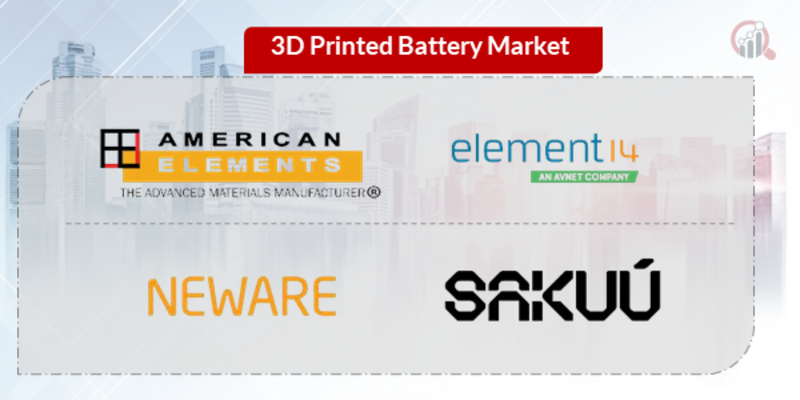3D Printed Battery Companies
With the increasing demand for lightweight, flexible, and high-performance batteries, the 3D printed battery market is poised for explosive growth.


With the increasing demand for lightweight, flexible, and high-performance batteries, the 3D printed battery market is poised for explosive growth.

*Disclaimer: List of key companies in no particular order
The Dynamic Landscape of 3D Printed Batteries: An In-Depth Exploration of Competition, Strategies, and Emerging Trends
The 3D printed battery market is currently characterized by a dynamic and competitive landscape, marked by ongoing innovation and intense rivalry among diverse players aiming for market dominance. This relatively new technology allows for the creation of intricately shaped, high-performance energy sources, making it a focal point for numerous companies seeking to establish their presence in this burgeoning sector. In this comprehensive analysis, we will delve into the strategies, trends, and influential factors shaping the evolving arena of 3D printed batteries.
Key Players and Their Strategic Approaches:
A multitude of companies are actively participating in the 3D printed battery market, each employing distinct strategies to carve out a niche for themselves. Notable players include Sakuu Corporation (US), Neware Technology Limited (China), American Elements (US), Element14 Electronics (Singapore), Stratasys Ltd. (Israel), Blackstone Resources (Switzerland), Photocentric (UK), GE Additive (US), 6K (US), EOS GmbH (Germany), among others.
Established Giants: Industry leaders like Solvay AG and Stratasys Ltd. leverage their extensive material expertise and 3D printing infrastructure to develop specialized filaments and printing processes for battery components. Notably, KeraCel focuses on advanced ceramic composite filaments tailored for high-performance applications in aerospace and drones.
Tech-Focused Startups: Emerging companies such as Neware and Blackstone Resources AG prioritize research and development efforts, pushing the boundaries of battery design and performance. For instance, Neware concentrates on solid-state electrolytes in 3D printed batteries, while Blackstone explores lithium metal printing for enhanced energy density.
Cross-Industry Collaborations: Collaborations across the value chain are becoming increasingly prevalent. Leading 3D printer manufacturers like 3D Systems and EnvisionTEC are partnering with material developers and research institutions to expedite the commercialization of 3D printed batteries.
Factors Influencing Market Share:
Several factors play a crucial role in determining the market share of companies operating in the 3D printed battery space.
Technology Leadership: Companies showcasing advancements in printing resolution, materials science, and battery architecture gain a competitive edge. Neware's high-precision micro-dispensing technology for solid-state electrolyte printing serves as a prime example.
Application Focus: Tailoring solutions for specific end-use sectors, such as wearable electronics, medical devices, or electric vehicles, enables companies to penetrate markets more deeply. Stratasys, for instance, focuses on healthcare with its biocompatible, 3D printed battery prototypes designed for implantable devices.
Intellectual Property Landscape: Securing patents and protecting core technologies is pivotal for maintaining a sustained competitive advantage. KeraCel's proprietary ceramic composite battery technology positions the company as a leader in high-temperature applications.
New and Emerging Trends:
As the 3D printed battery market evolves, several trends are shaping its trajectory.
Shift to Solid-State: The transition from liquid to solid-state electrolytes offers benefits such as enhanced safety, faster charging, and higher energy density. Companies like Neware and Blackstone are at the forefront of this shift, developing specialized printing processes for solid-state materials.
Biocompatible Batteries: Integrating 3D printing with biocompatible materials opens avenues for medical applications, such as implantable sensors and drug delivery devices. Stratasys' work in this area highlights the potential for personalized, patient-specific energy solutions.
Printed Electronics Convergence: The combination of 3D printing batteries with functional circuitry presents exciting possibilities for miniaturized, integrated devices. Companies like Voxeljet and HP are exploring this frontier, paving the way for smart textiles and flexible electronics.
Overall Competitive Scenario:
The 3D printed battery market is marked by intense competition, with established players leveraging their resources and startups driving innovation. Collaboration across the value chain and a focus on niche applications emerge as key strategies for success. Technological advancements, particularly in solid-state batteries and biocompatible materials, are pivotal in shaping the future landscape. As the market matures, consolidation is expected as dominant players emerge, influencing standards and future directions.
Future Outlook and Industry Updates:
The race for technological leadership and market share is intensifying, promising exciting developments in the years ahead. The dynamic and evolving landscape presents immense opportunities for both established players and innovative startups, shaping the future of energy storage and powering groundbreaking applications across diverse industries.
Industry Developments and Latest Updates:
Sakuu Corporation (US):
On December 15, 2023, Sakuu announced a strategic partnership with MAHLE, a leading global supplier of automotive components, to develop and commercialize 3D printed batteries for electric vehicles (Source: Sakuu press release).
American Elements (US):
On December 07, 2023, American Elements unveiled its new high-performance lithium metal anode material for 3D printed batteries, offering extended cycle life and improved safety (Source: American Elements press release).
Stratasys Ltd. (Israel):
On December 05, 2023, Stratasys announced the launch of its new J750 Prime 3D printer, capable of printing functional battery prototypes with conductive inks (Source: Stratasys press release).
Blackstone Resources (Switzerland):
On November 22, 2023, Blackstone Resources secured exclusive rights to a novel 3D printed battery technology with ultra-fast charging capabilities (Source: Blackstone Resources press release)
3D Printed Battery Market Highlights:
© 2025 Market Research Future ® (Part of WantStats Reasearch And Media Pvt. Ltd.)